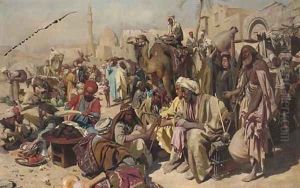Carl Leopold Mutller Paintings
Carl Leopold Müller was an Austrian painter, born on December 20, 1834, in Vienna, Austria. He was one of the notable artists of the 19th century, particularly recognized for his contributions to Orientalist painting, a genre that sought to depict the cultures and landscapes of the East. Müller's fascination with the Orient was a reflection of a broader interest in exotic locales that captivated European artists and audiences during this time.
After initial studies at the Academy of Fine Arts Vienna, Müller’s artistic journey led him to further his education and refine his skills across Europe, including significant time spent in Rome, Italy, which was a central hub for artists seeking inspiration and mastery in their craft. His time in Rome not only honed his technical skills but also exposed him to a network of artists and thinkers who were exploring new ideas and themes, including Orientalism.
Müller's travels to Egypt and the Near East profoundly influenced his artistic direction. He became known for his vivid portrayals of the people, architecture, and landscapes of these regions. His works are characterized by meticulous attention to detail, vibrant color palettes, and a keen ability to capture the atmospheric conditions of the Orient. Among his notable works are scenes of bustling markets, serene landscapes, and intimate portrayals of daily life that offer a window into the world as he saw it.
Beyond his Orientalist works, Müller was also respected for his historical paintings and portraits, which demonstrated his versatility and command over different genres. His contributions to art were recognized with several awards and honors in his lifetime, and he became a member of various prestigious art institutions across Europe.
Carl Leopold Müller's legacy is that of a bridge between cultures, capturing the allure and mystique of the East for European audiences. His death on June 9, 1892, marked the loss of a significant voice in the Orientalist movement, but his works continue to be celebrated for their beauty, technical skill, and the insights they provide into a world that was, at the time, largely unknown to his contemporaries. Müller’s paintings remain on display in museums and galleries around the world, serving as a testament to his enduring influence on the art world.
